Abstract
The uneven bars apparatus is part of women’s gymnastics polyathlon. Over time, this apparatus has had several modifications, which have gradually led to the evolution of the execution technique, an increase in the element difficulty and learning techniques. Scientific progress is an important factor that has led to the spectacular development of uneven bars. The state-of-the-art materials used in the construction of the apparatus, the decrease in the bar radius, the change in the distance between bars and the apparatus height have encouraged the emergence of new elements, within the limits of the regulations in force. The purpose of this study is to point out the evolution of the degree of difficulty and the share of the elements used by gymnasts in the composition of exercises performed in the apparatus finals at the Olympic Games, particularly on the uneven bars apparatus. Also, we want to present the elements which women gymnasts have used over time and whether there are certain elements that, if included in exercises, provide an advantage to certain women gymnasts. The methods used are: bibliographic study, observation, videographics, as well as mathematical, graphical and tabular methods. To this purpose, we analysed the exercises of women gymnasts presented on this apparatus in the finals of the Olympic Games since 1980 up today. Judging according to the regulations, we notice that the scores granted for difficulty are constantly increasing. This makes us conclude that the difficulty of exercises performed on uneven bars is constantly increasing.
Keywords: Women’s Artistic Gymnasticsuneven barsdifficulty of exercises
Introduction
The uneven bars apparatus is part of the women’s gymnastics polyathlon. Over time, this apparatus underwent several modifications. These modifications have gradually led to an evolution of the execution technique, an increase in element difficulty and learning techniques. Scientific progress is an important factor which has led to the evolution and increase in the beauty of performance on uneven bars. The cutting-edge materials used in the construction of the apparatus, the decrease in bars’ radius, and the modification of the distance between bars and the apparatus height have promoted the emergence of new elements, within the limits of the regulations in force.
In order to execute the integrals on uneven bars, the men’s apparatus was used, raising one of the bars higher. In 1952, starting with the Olympic Games held in Helsinki, the uneven bars event has become an official competition, without being an alternative to another competition.
In the late 1960s, the uneven bars apparatus began to be manufactured as a separate, specific apparatus. It was designed in such a way as to allow the bars to be adjusted.
The types of elements that could be executed at that time, when the two bars were close, are circles, underswings, casts, swings, in different forms, and the positions in which the elements were made, were hang, supported, sitting and seated. Characteristic of the integrals on uneven bars is the “continuous passage from one bar to the other, with the face, with one side or with the back towards the apparatus” (Stroescu, 1962, p. 10).
Nowadays, due to the changes made to this apparatus, numerous and unusual elements can be executed, performed with different bindings, bar-leaving elements, grip changes. When performing these elements, the body can move between the bars, outside them, below or above the bars (Vieru, 1997).
In the
The groups of uneven bars elements are:
Group 1 – Mounts;
Group 2 – Casts and clear hip circles;
Group 3 – Giant circles;
Group 4 – Stalder circles;
Group 5 – Pike circles;
Group 6 – Dismounts.
Elements are divided into subgroups according to the value of the element. These elements start from A value, 0.10 points, up to G value, 0.70 points.
A D scoring for Uneven Bars consists of 8 elements with the highest difficulty (VD), Compositional Requirements (CR) and Connection Value (CV).
Problem Statement
We highly recommend carrying out a scientific analysis for both the specialist and the athletes. Such analysis is aimed at evolving by increasing the complexity of exercises and introducing new elements in the exercises on uneven bars in the most important competitions, the Olympic Games. Given that this analysis is made only for exercises performed by highly-skilled top athletes who participated in the Uneven Bars Finals at the last ten Olympic Games. Five Olympic Games took place at the end of 2nd Millennium and the other five at the beginning of the 3rd Millennium. We consider it is interesting to see the number of items used by athletes and the groups of elements they belong to. We also mention that the elements that form the exercise presented in the contest must comply with certain regulatory requirements in order to be recognised by the panel of judges.
Research Questions
This analysis allows us to determine the prevalence of used elements and also which of them constitute the exercises of gymnasts on uneven bars between the two millennia.
The most used elements in the past millennium
What are the most used elements on uneven bars in the past millennium and to which groups of elements do they belong?
The most used elements in this millennium
What are the most used elements on uneven bars in this millennium and to which groups of elements do they belong?
Purpose of the Study
The purpose of this study is to point out the difficulty degree evolution and the share of elements used by gymnasts in the composition of exercises performed in the apparatus finals at the Olympic Games, particularly the uneven bars apparatus. We also want to show what elements have been used by gymnasts over time and whether there are elements that would deserve to be included in exercises.
Research Methods
The research methods used are the following: bibliographic study, observation, videographics, as well as mathematical, graphical and tabular methods. For this paper, we studied the
Findings
To accomplish the proposed aim, we analysed the exercises of gymnasts present in the Uneven Bars Finals at the Olympics, since 1980 to date. Exercises were analysed in terms of difficulty, according to the
In Table

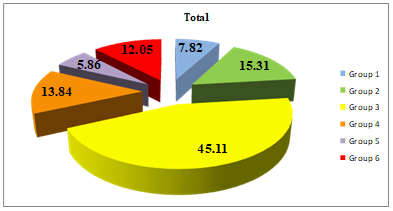
In Figures

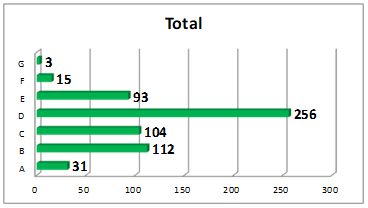
Figures

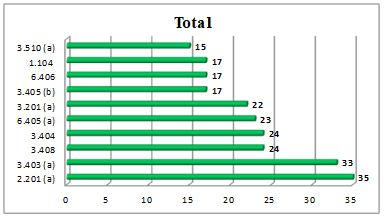
Figures
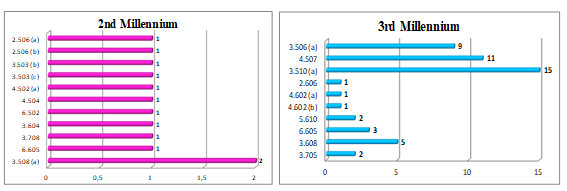
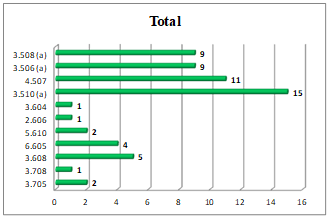
Figure
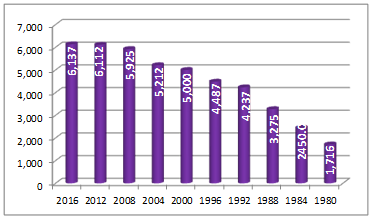
Conclusion
The number of elements in groups 1 (Mounts) and 2 (Casts and clear hip circles) decreased in the 3rd Millennium as compared to the 2nd Millennium. The number of elements executed in the other groups increased in the 3rd Millennium.
In the 2nd Millennium several valuable elements A, B and C were executed (0.1 - 0.3 points), and in the 3rd Millennium, more difficult elements, difficulty D, E , F, G (0.4 - 0.7 points). In total, over the past two millennia, most of the elements presented were of D value (0.4 points) and the lowest of G value (0.7 points). The latter are very difficult and risky, so they are not very often performed by gymnasts.
The most used elements in the 2nd Millennium were: 1 element in group 1 (Mounts), 3 elements in group 2 (Casts and clear hip circles), 5 elements in group 3 (Giant circles) and 1 element in group 4 (Stalder circles). Also, the values of these elements were: A (1 element), B (3 elements), C (4 elements) and D (2 elements). In the 3rd Millennium, the 10 most used elements were: 6 elements in group 3 (Giant circles), 2 elements in group 4 (Stalder circles) and 2 elements in group 6 (Dismounts). The values of these elements were: D (7 elements) and E (3 elements).
In the 2nd Millennium, eight E-elements were made, two F-elements and one G-element. In the 3rd Millennium, 3 E-elements were performed, 6 F-elements and 1 G-element. Overall, in all the 10 Olympic Games editions studied, the most valuable elements were E - 4 elements, F - 5 elements and G - 2 elements.
The score received for difficulty is constantly growing. This allows us to state that the difficulty of exercises presented on uneven bars is constantly growing.
References
- FIG. (2017). 2017-2020 Code of Points: Women’s Artistic Gymnastics (Section 11: Uneven Bars, pp. 73-106). Retrieved from http://www.fig-gymnastics.com/publicdir/rules/files/en_WAG%20CoP%202017-2020.pdf
- Gymnastics at the 1980 Summer Olympics – Women’s uneven bars. (2017). In Wikipedia. Retrieved from
- https://en.wikipedia.org/wiki/Gymnastics_at_the_1980_Summer_Olympics_%E2%80%93_Women%27_uneven_bars#Final
- Gymnastics at the 1984 Summer Olympics – Women’s uneven bars. (2016). In Wikipedia. Retrieved from
- https://en.wikipedia.org/wiki/Gymnastics_at_the_1984_Summer_Olympics_%E2%80%93_Women%27s_uneven_bars
- Gymnastics at the 1988 Summer Olympics – Women’s uneven bars. (2017). In Wikipedia. Retrieved from
- https://en.wikipedia.org/wiki/Gymnastics_at_the_1988_Summer_Olympics_%E2%80%93_Women%27s_uneven_bars
- Gymnastics at the 1992 Summer Olympics – Women’s uneven bars. (2016). In Wikipedia. Retrieved from
- https://en.wikipedia.org/wiki/Gymnastics_at_the_1992_Summer_Olympics_%E2%80%93_Women%27s_uneven_bars#Final
- Gymnastics at the 1996 Summer Olympics – Women’s uneven bars. (2016). In Wikipedia. Retrieved from
- https://en.wikipedia.org/wiki/Gymnastics_at_the_1996_Summer_Olympics_%E2%80%93_Women%27s_uneven_bars
- Gymnastics at the 2000 Summer Olympics – Women’s uneven bars. (2018). In Wikipedia. Retrieved from
- https://en.wikipedia.org/wiki/Gymnastics_at_the_2000_Summer_Olympics_%E2%80%93_Women%27s_uneven_bars
- Gymnastics at the 2004 Summer Olympics – Women’s uneven bars. (2018). In Wikipedia. Retrieved from
- https://en.wikipedia.org/wiki/Gymnastics_at_the_2004_Summer_Olympics_%E2%80%93_Women%27s_uneven_bars
- Gymnastics at the 2008 Summer Olympics – Women’s uneven bars. (2018). In Wikipedia. Retrieved from
- https://en.wikipedia.org/wiki/Gymnastics_at_the_2008_Summer_Olympics_%E2%80%93_Women%27s_uneven_bars
- Gymnastics at the 2012 Summer Olympics – Women’s uneven bars. (2018). In Wikipedia. Retrieved from
- https://en.wikipedia.org/wiki/Gymnastics_at_the_2012_Summer_Olympics_%E2%80%93_Women%27s_uneven_bars
- Gymnastics at the 2016 Summer Olympics – Women’s uneven bars. (2018). In Wikipedia. Retrieved from
- https://en.wikipedia.org/wiki/Gymnastics_at_the_2016_Summer_Olympics_%E2%80%93_Women%27s_uneven_bars
- Stroescu, A. (1962). Paralele inegale. București: Editura Uniunii de Cultură Fizică și Sport.
- Vieru, N. (1997). Manual de gimnastică sportivă. București: Driada.
Copyright information

This work is licensed under a Creative Commons Attribution-NonCommercial-NoDerivatives 4.0 International License.
About this article
Publication Date
16 February 2019
Article Doi
eBook ISBN
978-1-80296-054-9
Publisher
Future Academy
Volume
55
Print ISBN (optional)
-
Edition Number
1st Edition
Pages
1-752
Subjects
Sports, sport science, physical education
Cite this article as:
Gavojdea, A., & Corlaci, I. (2019). The Difficulty Of Exercises On Uneven Bars Between The Two Millennia. In V. Grigore, M. Stănescu, M. Stoicescu, & L. Popescu (Eds.), Education and Sports Science in the 21st Century, vol 55. European Proceedings of Social and Behavioural Sciences (pp. 438-445). Future Academy. https://doi.org/10.15405/epsbs.2019.02.55
